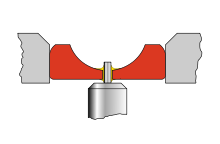Oil lowering

Oil sinking in a stone bearing (red) of a clock
An oil countersink is the spherical recess for the bearing of a journal in a watch .
It is used to absorb a lubricant or lubricating oil , usually a watch oil . The lowering of the oil is supposed to keep the lubricant used in its place ( surface tension ) so that it is available to the bearing and journal for a long time, flows when necessary and does not expand over the surfaces of the watch that cannot be oiled. To avoid excessive spreading of the lubricant, the work plate and stones are occasionally epilamized with a barrier layer .
The oil lowering has been known since the middle of the 18th century. Oil subsidence is typical for watches, but can also be found on other instruments.
Web links
Oil reduction lexicon
literature
- Otto Böckle, Wilhelm Brauns: Textbook for the watchmaking trade. Work skills and materials. 8-10 Edition. Wilhelm Knapp, Halle (Saale) 1951 (reprint, edited by Michael Stern. Heel, Königswinter 2010, ISBN 978-3-86852-288-4 ).
- Hermann Brinkmann: Introduction to watchmaking (= The watchmaking school. Vol. 2). 10th unchanged edition. Wilhelm Knapp, Düsseldorf 2005, ISBN 3-87420-010-8 .
- George Daniels : Watchmaking. Updated 2011 edition. Philip Wilson Publishers, London 2011, ISBN 978-0-85667-704-5 .
Individual evidence
- ↑ Fritz von Osterhausen: Callweys lexicon. Callwey, Munich 1999, ISBN 3-7667-1353-1 , p. 230.
- ↑ Lukas Stolberg: Lexicon of the pocket watch. 4th, completely revised edition. Carinthia-Verlag, Klagenfurt 1995, ISBN 3-85378-423-2 , p. 154.
